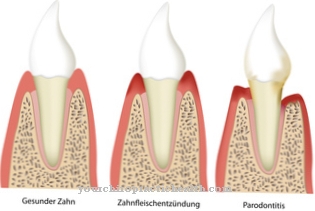As diffuse esophageal spasm In specialist circles, a mostly chronic movement disorder of the esophagus is called. In technical jargon, this disorder is called 'Motility disorder designated. There are repeated seizure-like muscle contractions of the esophagus, which can also cause pain in the sternum. The exact causes of the diffuse esophageal spasm are not clear.
What is Diffuse Esophageal Spasm?

© lom123 - stock.adobe.com
Diffuse esophageal spasm suddenly leads to strong and spasmodic contractions of the muscles in the esophagus. The smooth muscles are always affected. These contractions usually take place in the middle and lower areas of the esophagus. They do not have a propulsive effect on food and can cause pain behind the breastbone.
It is a stinging spasmodic feeling. This pain can also radiate into the shoulder and jaw up to the arms, and sometimes to the back. These complaints usually come on very suddenly. Difficulty swallowing can also occur.
The problems are usually very sudden and unexpected and can either be triggered by swallowing or occur spontaneously.
causes
The causes of a diffuse esophageal spasm are still unknown. It mostly affects older people, but young people can also suffer from this disease.
However, diffuse esophageal spasm has been associated with certain underlying diseases. People affected often suffer from one of the following diseases: diabetes mellitus, collagenosis, diseases of the central and peripheral nervous system, muscle diseases, amyloidoses and alcoholism.
Simultaneous contractions of the smooth muscles of the esophagus are responsible for the symptoms. These muscle contractions are associated with disorders of nervous regulation and the release of nitric oxide. However, these findings are not certain.
You can find your medication here
➔ Medication for heartburn and bloatingSymptoms, ailments & signs
This disease is associated with various complaints, which, however, can occur in different forms. In any case, they have a very negative effect on the patient's quality of life and limit it considerably. As a rule, the patients suffer from pain that occurs directly behind the sternum.
In particular, the ingestion of food and fluids can make this pain worse, so that many patients intentionally consume less food and fluids. This leads to swallowing difficulties and furthermore to dehydration and various deficiency symptoms. In some cases, the disease can also lead to shortness of breath, so that the patient's resilience drops and physical exertion can no longer be carried out easily.
Many people with this condition have to rely on a special diet to avoid making the symptoms of the condition worse. With an early diagnosis, however, the disease usually progresses positively and there are no particular complications. Furthermore, the illness can also have a negative effect on the psychological state of the person concerned and possibly lead to depression or other psychological upsets. As a rule, the life expectancy of the person affected is not reduced.
diagnosis
Diffuse esophageal spasm can be diagnosed by several methods. First, the doctor will have a detailed discussion with the patient about the medical history in order to discuss all complaints in detail. The person concerned should describe in detail which complaints occur, how often they occur, how long they last and have already existed. This makes it much easier for the doctor to decide which further examinations are useful in the present case.
An X-ray examination is very often used to diagnose diffuse esophageal spasm. The use of a contrast medium is necessary in order to achieve a useful result. The patient swallows a piece of bread that has been soaked with barium. The exact course of the piece of bread through the esophagus is then observed.
Irregular and corkscrew-like deformations of the esophagus can thus be recognized. A similar examination method is the so-called porridge swallowing method, in which a porridge mixed with a contrast medium is taken.
Complications
The disease can cause various symptoms and complications of the esophagus. In most cases, these manifest themselves in the form of swallowing difficulties, so that normal food and fluid intake is usually no longer possible for the patient. The quality of life is extremely reduced and everyday life is made more difficult for the patient.
It is not uncommon for this to result in underweight or dehydration, both symptoms representing a very unhealthy condition for the patient. Furthermore, acute shortness of breath can develop and the patient experiences severe pain. The diagnosis of the disease is usually made without complications and relatively quickly, so that treatment can be started early.
The treatment itself also usually takes place without complications, in which various drugs are used. In some cases, long-term use can trigger addictive behavior. For the patient, however, the diet also changes, so that fatty foods or alcohol have to be avoided. For mental health problems, antidepressants are used to treat the effects of pain relievers. The disease does not usually reduce life expectancy.
When should you go to the doctor?
If there is pain behind the breastbone, difficulty swallowing, and other signs of diffuse esophageal spasm, a doctor is recommended. If the symptoms have already led to dehydration or underweight, this must be clarified immediately. A quick examination by the family doctor is advisable, especially in the case of shortness of breath and severe pain.
If the course is severe - if the person concerned can no longer breathe properly or signs of pneumonia are noticed - relatives should contact the emergency medical service. After the treatment, a close inspection by the responsible doctor is indicated.
Depending on the severity of the disease, physiotherapeutic support can also be used to restore the former quality of life. Diffuse esophageal spasm is often associated with diabetes mellitus, collagenosis, muscle and nerve disorders, amyloidosis, and alcoholism. In the case of previous illnesses, signs of a movement disorder of the esophagus should be clarified promptly. Elderly and seriously ill people should have a diffuse esophageal spasm and other diseases excluded as part of the annual check-ups.
Doctors & therapists in your area
Treatment & Therapy
As a rule, the diffuse esophageal spasm is treated with purely medicinal drugs. Medicines such as acid blockers, muscle relaxers and psychotropic drugs come into question here. Muscle-relaxing preparations in particular usually have a very good effect. By relaxing the muscles in the esophagus, the spasmodic and painful seizures are avoided. The use of antidepressants can also have a positive effect on pain perception and ensure general relaxation.
Sometimes, however, there are also causes for the diffuse esophageal spasm that do not require drug treatment. The complaints can e.g. arise from alcohol consumption and incorrect eating habits. Then it helps to do without the triggering substances and to structure the daily meals differently.
Conscious eating is very helpful here. Allow sufficient time for each meal; swallowing the food quickly promotes problems in the esophagus. Likewise, each bite should be chewed thoroughly before swallowing the food. This simplifies transport into the stomach for the esophagus, but well-chewed food is also easier for the stomach to digest.
Relaxation exercises like yoga, meditation, or autogenic training can be very helpful and improve the symptoms of diffuse esophageal spasm.
If all attempts at therapy do not help, surgery can be carried out as the last resort. However, surgery is very rarely performed for diffuse esophageal spasm. The surgical procedure involved is called a myotomy. The esophageal musculature is split, but the lower area of the musculature is spared. Otherwise there is a risk of reflux disease.
Outlook & forecast
The prognosis of diffuse esophageal spasm is determined by the underlying disease and its severity. In a large number of cases, there is a good chance of a cure. For many patients, relaxation techniques are sufficient to achieve long-term relief from the symptoms. Especially with triggers such as stress or emotional tension, balancing exercises and training can be used to relax the entire musculature.
If alcohol consumption is responsible for the diffuse esophageal spasm, the prognosis is also favorable. With the discontinuation of consumption there is no symptom. If there is alcohol addiction, this must be treated in order to achieve recovery. If the eating behavior is incorrect, the patient is trained to chew in a targeted manner. This leads to an alleviation or a spontaneous healing of the disease.
If the symptoms are not free from the described options, medication is given. These release existing cramps and relieve the existing pain. As soon as the underlying disease is cured, the medicines are no longer needed, as the patient has recovered.
In the worst case, surgical corrections are made, which ultimately lead to an optimal swallowing act. Consequential damage rarely persists. Diffuse esophageal spasm can recur at any time. The prognosis remains optimistic if it returns. Healthy eating habits and a good chewing process reduce the recurrence rate.
You can find your medication here
➔ Medication for heartburn and bloatingprevention
There is no direct way to prevent diffuse esophageal spasm. Psychological disorders can be the trigger as well as wrong food intake. It is therefore important to ensure inner balance and to plan meals consciously.
Sufficient chewing and enough time to eat are important. Gulping down large pieces of food is not good for the muscles of the esophagus. Despite these precautionary measures, diffuse esophageal spasm can occur in anyone.
Aftercare
With this disease, the person affected usually has very few or even no follow-up measures available. The person affected is primarily dependent on early detection of the disease. This is the only way to avoid further complications and complaints, and if left untreated, the symptoms will worsen.
The earlier the disease is recognized, the better the further course is usually. Therefore, early diagnosis is paramount. The disease is usually treated by taking medication. In any case, the person affected should ensure that they are taken regularly and correctly and continue to observe the correct dosage.
If you have any questions or are unclear, you should always consult a doctor first so that there are no further complaints. Furthermore, a healthy lifestyle with a healthy diet can have a positive effect on the further course. The person affected should avoid fatty or very sweet foods and eat light foods. Various therapies can also contribute to relaxation in order to alleviate the symptoms of the disease. Further follow-up measures are usually not necessary.
You can do that yourself
A characteristic of diffuse esophageal spasm is that the strong and spontaneously occurring contractions of the smooth muscles of the esophagus are not directed. This means that they do not move any food that may be in the esophagus. A reason for the spontaneous and often painful contractions is usually not apparent. These are contractions with a wave of contraction that occur independently of the directed motility when swallowing.
Because the etiology of the contractions that occur is usually not known, but eating habits, excessive alcohol consumption and psychological factors are often also blamed, those affected can achieve improvements by adapting their behavior in everyday life and through self-help measures - also accompanying any drug treatment.
Above all, eating behavior and - if applicable - alcohol consumption behavior should be critically reviewed and adjusted if necessary. This also includes checking the daily menu. The food consumed should be as easy to digest as possible, contain natural components such as vegetables and fruit and only contain a few difficult to digest components such as high-fat products of animal origin.
Since it is very likely that the psyche also plays a not insignificant role in the development of diffuse esophageal spasm, the regular use of relaxation techniques such as yoga, autogenic training and meditation as self-help measures can help to overcome the disease.




.jpg)







.jpg)

.jpg)
.jpg)











.jpg)